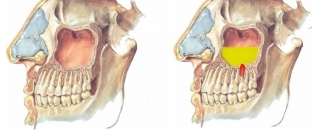Each organ of the human body can be subject to pathological processes. Inflammation, polyps, cysts, ulcers, stratifications, synechiae, protrusions and penetrations & hellip; each system has its own pathological processes. The oral cavity is no less prone to such conditions. One of the most dangerous and unpleasant diseases of the oral cavity is a cyst on the root of the tooth. The insidiousness of this condition lies in the difficulty of diagnosing the process at an early stage.
What causes the development of a cyst on the root of a tooth?
A cyst on the root of a tooth appears most often against the background of untreated periodontitis. A long-standing inflammatory process in the periodontium provokes the development of a protective mechanism, which consists in the growth in the upper part of the tooth root. First, a granuloma is formed, which, with prolonged existence, is filled with fluid and a cyst is formed. The reason for the formation of a cyst can be periodontitis, caries, dislocation or trauma of the tooth, chronic diseases of the nasopharynx, pulpitis.
A cyst on the root of a tooth is a round formation in the form of a bladder, which has thin walls of epithelium. Inside the cyst contains a mushy or liquid content, which contains dead cells and bacteria. This bubble is enveloped by connective tissue - this is a protective reaction of the body, consisting in the isolation of the bacterial focus from the bone. But, unfortunately, such a process has a pathological character.
What are the symptoms of a cyst growing on the root of a tooth?
With small sizes, the cyst on the root of the tooth does not appear and remains undiagnosed. Growing in size, the cyst gradually destroys healthy tissue. Acquiring large sizes, the cyst strikes at the state of the whole organism. At this stage, the cyst is already making itself felt – body temperature rises, regional lymph nodes increase, a runny nose appears, which can turn into sinusitis. There is pain in the jaw, which does not have a clear localization, discomfort while chewing food. At a later stage of the cyst, a flux is formed on the root of the tooth – the gums and cheeks swell, and the swelling and pain interfere with the normal opening of the mouth.

Possible complications of a cyst on the root of a tooth
If you do not find a cyst on the root of the tooth at a late stage, without attaching importance to the symptoms, the following complications are possible:
- Inflammation of the lymph nodes.
- The transition of the cyst into a purulent form.
- Melting of bone tissue against the background of constant growth of a cyst on the root of the tooth.
- Formation of phlegmon on the neck due to a long-term purulent process.
- Development of osteomyelitis or periostitis.
- Fracture of the jaw at the site of thinning of the bone due to the growth of the cyst.
- Development of sepsis with blood poisoning.
As for the tooth itself, it is very likely to be lost if a cyst on the root of the tooth is not diagnosed in time.
What methods are used to treat a cyst on the root of a tooth?
When establishing a diagnosis of a cyst on the root of a tooth, it is supposed to be treated in two ways - conservative and surgical. The conservative method is considered gentle, but it rarely brings the desired results. Conservative treatment consists in opening, unsealing the tooth, followed by cleaning the canal and plugging the tooth with a special paste.
After such treatment, the patient needs to be regularly observed by the dentist for several months to assess the effectiveness of the treatment and the dynamics of the process using X-ray examination. In the absence of a cyst on the root of the tooth, the treatment is considered successful and complete. If the cyst remains, they resort to surgical treatment.
The most recent and effective method of surgical treatment of a cyst on the root of a tooth is cystectomy, during which the damaged upper part of the tooth root and the cyst are removed. This operation guarantees a good result of treatment. Prevention of the formation of a cyst on the root of the tooth lies in proper oral hygiene and timely access to the dentist.







Add a comment